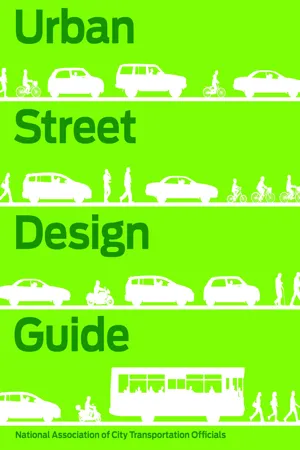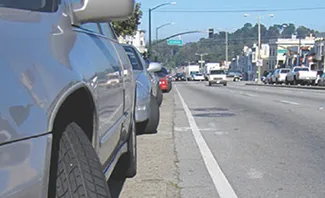
- English
- ePUB (mobile friendly)
- Available on iOS & Android
eBook - ePub
Urban Street Design Guide
About this book
The NACTO Urban Street Design Guide shows how streets of every size can be reimagined and reoriented to prioritize safe driving and transit, biking, walking, and public activity. Unlike older, more conservative engineering manuals, this design guide emphasizes the core principle that urban streets are public places and have a larger role to play in communities than solely being conduits for traffic.
The well-illustrated guide offers blueprints of street design from multiple perspectives, from the bird's eye view to granular details. Case studies from around the country clearly show how to implement best practices, as well as provide guidance for customizing design applications to a city's unique needs. Urban Street Design Guide outlines five goals and tenets of world-class street design:
• Streets are public spaces. Streets play a much larger role in the public life of cities and communities than just thoroughfares for traffic.
• Great streets are great for business. Well-designed streets generate higher revenues for businesses and higher values for homeowners.
• Design for safety. Traffic engineers can and should design streets where people walking, parking, shopping, bicycling, working, and driving can cross paths safely.
• Streets can be changed. Transportation engineers can work flexibly within the building envelope of a street. Many city streets were created in a different era and need to be reconfigured to meet new needs.
• Act now! Implement projects quickly using temporary materials to help inform public decision making.
Elaborating on these fundamental principles, the guide offers substantive direction for cities seeking to improve street design to create more inclusive, multi-modal urban environments. It is an exceptional resource for redesigning streets to serve the needs of 21st century cities, whose residents and visitors demand a variety of transportation options, safer streets, and vibrant community life.
The well-illustrated guide offers blueprints of street design from multiple perspectives, from the bird's eye view to granular details. Case studies from around the country clearly show how to implement best practices, as well as provide guidance for customizing design applications to a city's unique needs. Urban Street Design Guide outlines five goals and tenets of world-class street design:
• Streets are public spaces. Streets play a much larger role in the public life of cities and communities than just thoroughfares for traffic.
• Great streets are great for business. Well-designed streets generate higher revenues for businesses and higher values for homeowners.
• Design for safety. Traffic engineers can and should design streets where people walking, parking, shopping, bicycling, working, and driving can cross paths safely.
• Streets can be changed. Transportation engineers can work flexibly within the building envelope of a street. Many city streets were created in a different era and need to be reconfigured to meet new needs.
• Act now! Implement projects quickly using temporary materials to help inform public decision making.
Elaborating on these fundamental principles, the guide offers substantive direction for cities seeking to improve street design to create more inclusive, multi-modal urban environments. It is an exceptional resource for redesigning streets to serve the needs of 21st century cities, whose residents and visitors demand a variety of transportation options, safer streets, and vibrant community life.
Frequently asked questions
Yes, you can cancel anytime from the Subscription tab in your account settings on the Perlego website. Your subscription will stay active until the end of your current billing period. Learn how to cancel your subscription.
No, books cannot be downloaded as external files, such as PDFs, for use outside of Perlego. However, you can download books within the Perlego app for offline reading on mobile or tablet. Learn more here.
Perlego offers two plans: Essential and Complete
- Essential is ideal for learners and professionals who enjoy exploring a wide range of subjects. Access the Essential Library with 800,000+ trusted titles and best-sellers across business, personal growth, and the humanities. Includes unlimited reading time and Standard Read Aloud voice.
- Complete: Perfect for advanced learners and researchers needing full, unrestricted access. Unlock 1.4M+ books across hundreds of subjects, including academic and specialized titles. The Complete Plan also includes advanced features like Premium Read Aloud and Research Assistant.
We are an online textbook subscription service, where you can get access to an entire online library for less than the price of a single book per month. With over 1 million books across 1000+ topics, we’ve got you covered! Learn more here.
Look out for the read-aloud symbol on your next book to see if you can listen to it. The read-aloud tool reads text aloud for you, highlighting the text as it is being read. You can pause it, speed it up and slow it down. Learn more here.
Yes! You can use the Perlego app on both iOS or Android devices to read anytime, anywhere — even offline. Perfect for commutes or when you’re on the go.
Please note we cannot support devices running on iOS 13 and Android 7 or earlier. Learn more about using the app.
Please note we cannot support devices running on iOS 13 and Android 7 or earlier. Learn more about using the app.
Yes, you can access Urban Street Design Guide by National Association of City Transportation Officials in PDF and/or ePUB format, as well as other popular books in Architecture & Architecture General. We have over one million books available in our catalogue for you to explore.
Information
Street Design Elements
33 Lane Width
37 Sidewalks
38 Sidewalk Zones
40 Sidewalk Design
45 Curb Extensions
47 Gateway
48 Pinchpoint
49 Chicane
50 Bus Bulbs
51 Vertical Speed Control Elements
53 Speed Hump
54 Speed Table
55 Speed Cushion
57 Transit Streets
58 Dedicated Curbside/ Offset Bus Lanes
60 Dedicated Median Bus Lanes
61 Contra-Flow Bus Lanes
62 Bus Stops
65 Stormwater Management
67 Bioswales
68 Flow-Through Planters
69 Pervious Strips
70 Pervious Pavement
The elements that make up city streets, from sidewalks to travel lanes to transit stops, all vie for space within a limited right-of-way. Transportation planners and engineers can use this toolbox to optimize the benefits the community receives from its streets.

Lane Width
The width allocated to lanes for motorists, buses, trucks, bikes, and parked cars is a sensitive and crucial aspect of street design. Lane widths should be considered within the assemblage of a given street delineating space to serve all needs, including travel lanes, safety islands, bike lanes, and sidewalks. Each lane width discussion should be informed by an understanding of the goals for traffic calming as well as making adequate space for larger vehicles, such as trucks and buses.


Travel lanes are striped to define the intended path of travel for vehicles along a corridor. Historically, wider travel lanes (11–13 feet) have been favored to create a more forgiving buffer to drivers, especially in high-speed environments where narrow lanes may feel uncomfortable or increase potential for side-swipe collisions.
Lane widths less than 12 feet have also historically been assumed to decrease traffic flow and capacity, a claim new research refutes.1
DISCUSSION
The relationship between lane widths and vehicle speed is complicated by many factors, including time of day, the amount of traffic present, and even the age of the driver. Narrower streets help promote slower driving speeds. which in turn reduce the severity of crashes. Narrower streets have other benefits as well, including reduced crossing distances, shorter signal cycles, less stormwater, and less construction material to build.
Lane widths of 10 feet are appropriate in urban areas and have a positive impact on a street’s safety without impacting traffic operations. For designated truck or transit routes, one travel lane of 11 feet may be used in each direction. In select cases, narrower travel lanes (9–9.5 feet) can be effective as through lanes in conjunction with a turn lane.2
RECOMMENDED
Lanes greater than 11 feet should not be used as they may cause unintended speeding and assume valuable right-of -way at the expense of other modes.
Restrictive policies that favor the use of wider travel lanes have no place in constrained urban settings, where every foot counts. Research has shown that narrower lane widths can effectively manage speeds without decreasing safety and that wider lanes do not correlate to safer streets.3 Moreover, wider travel lanes also increase exposure and crossing distance for pedestrians at intersections and midblock crossings.4
Use striping to channelize traffic, demarcate the road for other uses, and minimize lane width.

SAN FRANCISCO, CA
Striping should be used to delineate parking and curbside uses from the travel lane.


Additional lane width may also be necessary for receiving lanes at turning locations with tight curves, as vehicles take up more horizontal space at a curve than a straightaway.
Wide lanes and offsets to medians are not required but may be beneficial and necessary from a safety point of view.
OPTIONAL



ELMORE, OH
Wider travel lanes are correlated with higher vehicle speeds.


“As the width of the lane increased, the speed on the roadway increased... When lane widths are 1 m (3.3 ft) greater, speeds are predicted to be 15 ...
Table of contents
- Cover
- Title Page
- Copyright Page
- Contents
- Foreword
- ix About the Guide
- Streets
- Street Design Elements
- Interim Design Strategies
- Intersections
- Intersection Design Elements
- Design Controls
- Resources